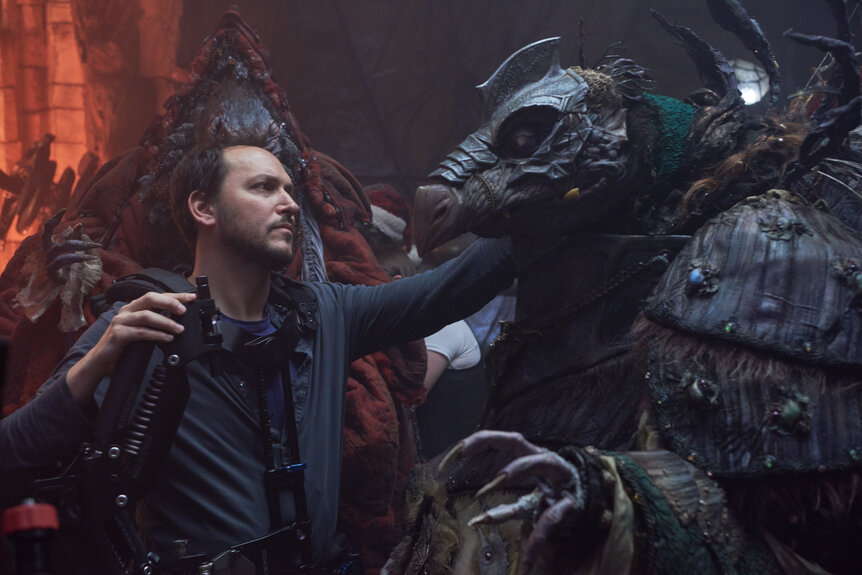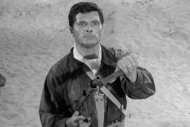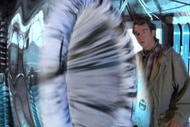Create a free profile to get unlimited access to exclusive videos, sweepstakes, and more!
The Dark Crystal prequel's decades long, labyrinthian journey to Netflix

And Netflix's Dark Crystal: The Age of Resistance takes place a thousand years before the events of the original 1982 puppet fantasy epic, and for longtime fans of the property, it feels like it's been nearly that long since the first rumors of a feature follow-up first began to circulate.
Even before he had completed the exhausting five-year production of The Dark Crystal, Jim Henson was already thinking up ideas for a potential sequel. But while he had a near-limitless imagination, the harsh reality of the film's lukewarm critical reception and modest box office take dashed any immediate hopes of making another story about the noble Gelfling and evil Skeksis. Even after home video made The Dark Crystal a cult hit in the decades that followed, developmental snafus further delayed any return to the mystical world of Thra. That long struggle makes the Friday premiere of Dark Crystal: The Age of Resistance on Netflix all the more momentous — even if it's in a very different format than anything Henson could have imagined.
The two-plus decades after the release of The Dark Crystal were largely rocky for The Jim Henson Company. Its namesake died tragically in 1990, leaving the company in the care of his two children, Lisa and Brian Henson. The company's Muppet movies and shows slumped critically, while the brief stint under the ownership of a German company saw the sale of Sesame Street. In 2004, the Hensons sold the Muppets to Disney, leaving the puppetry studio with a few legacy franchises to revive (along with various other work to keep the lights on). The Hensons set to work, and The Dark Crystal, the project their father had treasured most, was up first.
They made a splash in 2006, when they announced that animation guru Genndy Tartakovsky, creator of Star Wars: The Clone Wars and Samurai Jack, would direct Power of the Dark Crystal, a sequel written by original Dark Crystal screenwriter Dave Odell. The story was pulled from elements of Odell's original brainstorming sessions with Jim Henson, and the movie's release would be accompanied by an array of ancillary media, including an original manga prequel set in the world of Thra. The manga was published, but the movie got held up in development, a victim of financial uncertainty during the economic crisis — this, despite a big presentation during San Diego Comic-Con in the summer of 2006.
Tartakovsky eventually left the project — he'd go on to create the Hotel Transylvania franchise — and the Hensons would try to make it happen with other directors and financiers, to no avail. Odell's script was eventually turned into a sequel comic book series, also titled Power of the Dark Crystal. Things seemed grim, but a general meeting with a hot new filmmaker would eventually prove to be a decisive turn for the beleaguered project.
Louis Letterier grew up the son of a filmmaker, so movie magic was more mundane for him that most kids his age. But when he saw The Dark Crystal as a child, he was gobsmacked. He understood on some level that there were puppeteers controlling the Gelfling and Skeksis creatures, but the mystery of the obviously-arduous process and the empathy he felt for the foam and fuzz puppets (as well as the fear they invoked in him) were transformative.
"It was a movie that I, like a lot of people, watched too young, and it traumatized me," Leterrier tells SYFY WIRE, laughing. "It scared me, but it also made me want to become a filmmaker."
Leterrier made a splash with his 2010 hit Clash of the Titans, which earned him a general interest meeting with the Hensons the following year. He left that 2011 meeting with the keys to Thra, and at the time, the plan was to produce two different Dark Crystal projects: a live-action puppet sequel (different from the Odell script) and an animated prequel.
Leterrier says he was most drawn to working with puppets, but also wanted to tell a prequel story that answered questions that had lingered in his mind for years: "I had more questions ultimately about what led civilization to become extinct."
The two projects were in development for years, with Leterrier working on scripts and concepts in between other directing jobs, taking the Dark Crystal with him to far-flung sets in South Africa, New Orleans, and other places. The Hensons continued to shop the project, and ultimately got a meeting with Netflix, which consumes content like a massive blue whale. Leterrier joined, with a firm agenda.
"They said, 'Well, Louie, how do you see it then? I said, 'Puppet — sorry, but puppets," Leterrier remembers. "I was thinking that maybe they would say, 'all right, here's the door, leave.' And they said all right, and the next day they said, 'Good news, bad news: Bad news we're not going to do the Dark Crystal animation project, but we want to do this full puppet idea."
This was, of course, entirely good news to Leterrier.
Before they plunked down the massive production, however, Netflix wanted to get an idea of what this modern Dark Crystal, made by a filmmaker who had never worked with puppets, might look like. And so, Netflix execs, led by Dark Crystal superfan Ted Biaselli, asked Leterrier and The Jim Henson Company to make a short film, which they also paid for.
"They gave us a big sum of money and we did a little short movie," he says. " They were like, try different techniques and mix some CG with some puppets and do the whole thing. Let's really do a proof of concept short film, telling the story using every trick of the trade."
Jeffrey Addiss and Will Matthews had spent the last few years prolifically writing and selling screenplays to different studios in Hollywood. None of them had yet made it into production, but they were still known around town as hot young writers whose ideas were worth a meeting. And they had a lot of ideas — "Will and I break stories for fun," Addiss admits, laughing.
One of the stories they cooked up was a sequel to Labyrinth, Henson's iconic David Bowie puppet movie that may have scared even more children than Dark Crystal. Henson wasn't looking for any pitches on a Labyrinth sequel, but they did just so happen to get some money from Netflix to work on a Dark Crystal test short.
Whether or not that was clearly communicated to the two writers is still uncertain.
"It was Jeff's favorite thing growing up, so we were very excited, and so we worked really hard on our pitch for our sequel feature, and we go in to meet with Lisa Henson and she says 'I'm so glad you're here to tell me your idea for our prequel TV show,'" Matthews remembers, laughing. "And we said, 'No problem, absolutely, here's what we got.' And we sort of tap danced a little bit, but got out some of the big beat themes, the broad brush stuff."
What could have been an abject disaster ultimately went well enough that they were able to come back a week later, this time with Leterrier in the room. They pitched for a prequel they actually had brainstormed this time eventually, a few meetings with Netflix got them the green light.
The short film, which Addiss and Matthews also wrote, took three or four months to shoot, according to Leterrier, and used both puppets and CGI-created creatures. It mostly featured the evil Skeksis chasing around the village-dwelling Gelflings, with a few tiny Podlings thrown in for good measure. Leterrier calls it a crash course of sorts, his education in puppetry — they built sets, figured out how to operate the new versions of these puppets, and mixed in some visual effects.
The CGI, he says, came back "a little rough," because they were on an expedited schedule to make the short, but it was clear that no matter how much time they had spent in post-production, there would be a disconnect.
"It didn't have what that special thing that the Dark Crystal movie had," he says. "They were kind enough to wait until the end of the show, but they very quickly they were turning their heads and nodding. I was like, 'God, what are they talking about?' And then they said, All right, 100 percent puppets. Go for it.' And that was it. That literally was it. They signed a big check in the beginning."
In the years both before and during the production of Age of Resistance, Henson had released a series of YA prequels, which along with occasional story summits, provided Addiss and Matthews a base upon which to build the new series. Joe Lee, who wrote those books, was a frequent presence in the writer's room, helping to keep the canon all straight and serving as a resource otherwise. It was important for Henson to keep all the story threads consistent, no matter how small the detail or source.
The series, which debuts on Friday, tells a story that takes place a thousand years before the original movie; there are seven tribes of Gelflings now, all subjected to the increasingly autocratic and danger rule of the buzzard-like Skeksis. Only five episodes were made available to the press, but while logic and the original film might dictate that the Gelfling hero Rian will fail in his attempt to overthrow the Skeksis, the writers tease that that may not be the case. And regardless of how this season ends, they're hoping for a season two as well as a universe of ancillary material.
"I'm very excited to hand that story off to the next generation in whatever way that they go tell," Addiss says. "Thra's a big place, so I'm like 'come on in and tell your story.'"




























